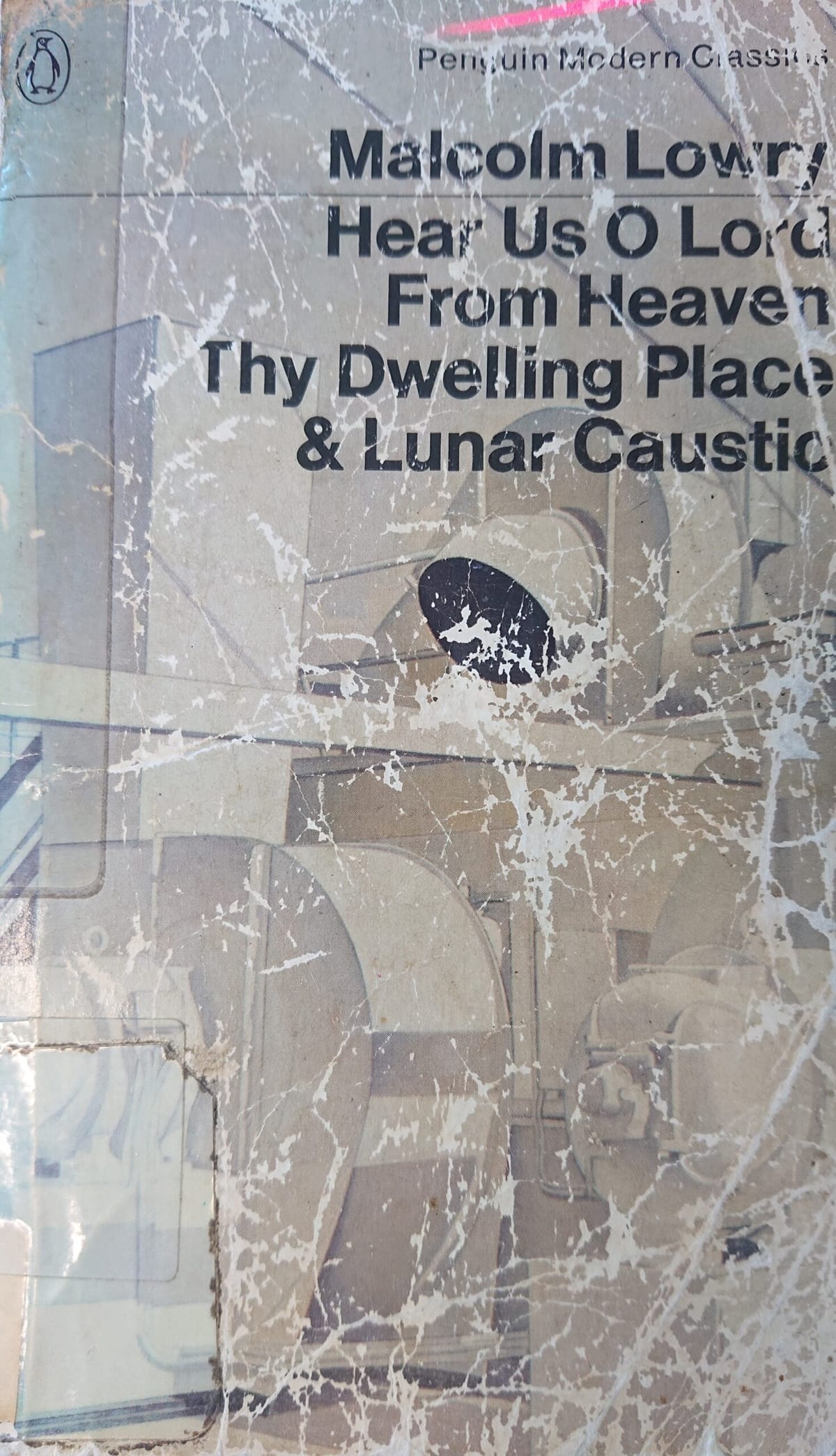bookmarked (Ig, NY: 2017): things forgotten because at the time perfectly usual

Hotel lobbies and bars late at night, things you did and for a time forgot because at the time these things were perfectly usual.
— David Ryan, Malcolm Lowry's Under the Volcano, 135
I studied Under the Volcano for Chris Ackerley's English class at Otago University in 1982 and wrote an essay on the kabbalah's role in the novel, in which I used the word hypostatises. Chris liked the essay so much—I'd done my research on kabbalah, in particular the kabbalah of Isaac Luria, at Knox College theological library—he wanted to include some details from it, the scintillations of sunlight on broken bottles as if the sparks of souls on (Qlipphoth) our world of husks and shells, in his A Companion to Under the Volcano.
Professor Emeritus Chris Ackerley after 39 years teaching had this to say in his farewell lecture:
“I do regret that – it seems to me – the University is heading toward a kind of banality. The pressure to document every part of our life has encouraged a kind of managerial mentality. I don't blame Otago; I think it's the way the world has gone in many, many spheres. There isn't the same tolerance of eccentricity that used to be part of the university experience.”
Everything stated or expressed by man is a note in the margin of a completely erased text.
— Fernando Pessoa, at Ryan, op.cit., 13
I requested Ryan's book on Under the Volcano from the library while putting together a list of personal best-loved books, had no intention of reading it until opening it at random I found this:
Henri Bergson, the late-nineteenth / early-twentieth century philosopher, describes consciousness as duration. Inside this duration are internal circuits, an ongoing ricocheting of lightning, let's say—an enchainment of thoughts passing like film cells through absolute darkness [see my work on Bergson and cinema]. The darkness is our unconsciousness. It's both ever-present, and nonexistent. We don't have access to it. But consciousness moves through that darkness and the circuits of our awareness light up and expose in little flashes: these flashes are then each moment we are aware of. Madness, in a sense, is just a state where too much of the unconscious is leaching into those illuminated moments.
Let's say then that each duration is structured with a collection of shelves: Bergsonian "planes of consciousness." On these shelves sit different ideas that haven't yet materialized. They're sitting there in a dynamic state—currently invisible, but ready to bloom. They're like mental photographs that haven't been developed, pre-images. The process of becoming—this is all our consciousness can do. It can take certain hidden pre-ideas in the unconscious (Bergson calls them "pure memories") and make them come to light, along a particular shelf, this plane of consciousness. Then we move onto another plane of consciousness, take something from that. So on and so forth.
But the thing is: consciousness never fully arrives at some final point. It is always in a state of becoming. It's never actualized. One idea in a circuit lead to another, and another. There is no final circuit, no cadence, except in an end to consciousness, death. Our conscious life is simply an endless circuitry of ideas forming, becoming, but never fully formed, never arrived.
It's no different than the creative act of writing narrative. Because, really: when is a story truly finished? Every narrative act is a duration—a consciousness. The potential is there for narrative to run forever, to perpetually unwind without ever running out of string.
The revelation of reading Bergson so recently has had a profound effect on me. It's crystallized so many ideas I've had about writing. Bergson's ideas couldn't be better suited to grappling with Lowry's method, his aesthetic. In one of his journal entries (collected in Perle Epstein's The Private Labyrinth of Malcolm Lowry), Lowry wrote:
The minute an artist begins to try and shape his material—the more especially if that material is his own life—some sort of magic lever is thrown into gear, setting some sort of celestial machinery in motion, producing events or coincidences that show him that this shaping of his is absurd, that nothing is static or can be pinned down, that everything is developing or evolving into other meanings, or cancellations of meanings, quite beyond his comprehension. There is something mechanical about this process symbolized by the watch: on the other hand, the human mind or will or consciousness or whatever, of which the owner knows nothing at all, yet which has a will of its own, becomes automatically at such moments in touch, as it were, with the control tower of this machinery.
Bergson describes our illuminated moments as constellations of synchronic cells: or crystal images—faceted, non-linear, reflecting many different elements. These crystalized images move along a timeline, let's say. But all of the things glimmering from their facets hang in space. They, like each moment of Lowry's book, aren't really moving through time. They're lined, floating in the sky of the story.
. . . Matter and Memory is cited as the book Ryan has been reading. But for taking his metaphors from the fields of electronics and cinema what he has to say about narrative is fascinating. No less interesting is the correspondence he finds, perhaps unknowingly, between Bergson's crystal images and Deleuze's time-crystals in the cinema books.
I see it everywhere: narrative, like our . . .
The other misreading, common to readers of Bergson, is that below duration time as we normally know it, as if we do, linear time that is, goes on mechanically ticking. Duration or what is for Bergson real time is the exception; but this view of time belongs rather to habit, including habitual ways of thinking, than reality.
. . . thought processes, is an oscillation of thousands and thousands of these pulses of experience, all operating simultaneously. We are conscious of only some of these pulses at any moment. Our creative minds pick from the circuitry. We find a particular plane of consciousness, take one synapse from that. We take another synapse from another plane. Each synapse, a cinematic cell . . .
how Bergson sees cinema is as strings of stills mechanically animated, however this would seem to be gainsaid by the view he has of matter being images and of the brain being an image among images
. . . of film. Certain shelves hold objects from our own lives, perhaps directly, without any embroidering. Episodic. They wait as a latent memory, invisible, but ready to begin pulsing. Other shelves produce something else entirely, less tied to our own episodic memories, but bound just the same to something that we feel connected to. Semantic, fragmentary, like conversation among strangers, overheard and filed away. Some composite stashed in the generator of the imagination.
— Ryan, op.cit., 119-122
a page later:
This is a Bersonian "duration":
no, it's not. For Bergson there are no moments and so no moments of duration, it is irreducible.
a moment moving through the dark, with occasional flashes of vision. Each flash, a particle of consciousness. And this particle is tagged on to the previous particle and the previous. So on and so forth. Internal circuits.
This could come from Bergson's view of the brain as a telephone exchange, calls being manually put through, forming a circuitry of loops; but these are loops of association, all inner experience is association. Perception is outside and has nothing to do with knowledge, knowledge belongs to inner experience, it is as soon a matter of memory data, facts, as it is of hallucination.
Little connections, branches of synaptic lightning connecting and forming an idea in progress, a becoming. All the while a whole world lives in the dark, our unconscious, around us. We have no idea.
Excellent reader of Deleuze, Jean-Jacques Lecercle suggests that the unconscious world is not in the dark but in the light, that it is the world outside (possibly outside our associations).
I agree with Ryan, we have no idea, which is not to say that ideas do not have themselves.
Bergson said that our past and the present occupied the same space. The past isn't in the past, distanced from us in time.
Bergson in fact doesn't spatialise like this, he considers it a tendency of language, and one, although it is difficult, to be overcome.
It's living with us at every moment of the present.
Yes, but—no moments . . .
Everything that happened years ago is coexisting . . .
the key word
with everything that we believe is happening now. It's all gathered up in our brains, in the circuitry of consciousness.
Every story, a duration, a consciousness. A gathering up of a past with its own internal circuitry, its own capacity for memory.
Ryan makes memory primary. Again, this is common for readers of Bergson, it is a common bias.
— Ibid., 132
The words of a sentence may move forward in a line, but their worth, all of it, gathers up in the space inside us called memory.
—Ibid., 133
We take a snapshot of our existing state at the moment of any perception. That perception, that single film cell, is sealed in time—the present, which immediately becomes the past. In that cell we are recorded too, with all the knowledge and experience, all our influences up to that time. These becomes [sic] data bits of the perception, the memory. Later, if we recall this moment, we see this episode, play it back, along with the event. And we remember too how we were at the time. But that person has died. The person was sealed away within that particular frame.
. . . but isn't it like food? what was dead at the supermarket coming back to life in being cooked, a kind of ritual, says Agustín Fernández Mallo, The Things We've Seen, Trans. Thomas Bunstead, (Fitzcarraldo, UK: 2021), 25
— Ryan, op.cit., 149-150
. . .
Ryan also talks about stereoscopic images having temporal depth, in Proust, who, he says, uses the word stereoscope 18 times. Coincidentally so does Mallo in The Things We've Seen. The narrator is travelling around the islands of San Simón and San Antón (my father's name was Anthony) with a book on their history finding the locations of past events recorded by photos in it and, from the same angle, photographing them as they appear to him. Ryan's examples are written.
Walter Benjamin's dialectical images, although he appropriates the device itself from cinematic montage, are also written. Stuart Jeffries in Hotel Grand Abyss, 2016, gives a clear description of what he thinks Benjamin means by dialectical image. His intention, says Jeffries, is to explode our belief in the fetishes produced by capitalism's commodity culture by showing the objects that we fetishised in the past alongside them. Once we see how pathetic they really are now, those we venerated in the past, we will see the ones in the present as equally pathetic.
a final note is provided by Mallo, from The Things We've Seen, 26-27:
I said to them that in my view the important thing about the internet was its bodilessness – the fact of it being, in a manner of speaking, one gigantic brain that drifts around the planet without ever encountering the fat, muscles and bones that would tether it to the earth, and that as it drifts it projects all manner of different shadows, which, paradoxically, don't come about through contact with any kind of body either. Hence the confusion, I continued, concerning everything to do with the net: it's a primitive organism, still only half-finished, in a phase similar to that of the microorganisms that one day clambered out of the water, millions of years before they became the amphibians that were the precursors of the humans of today.

